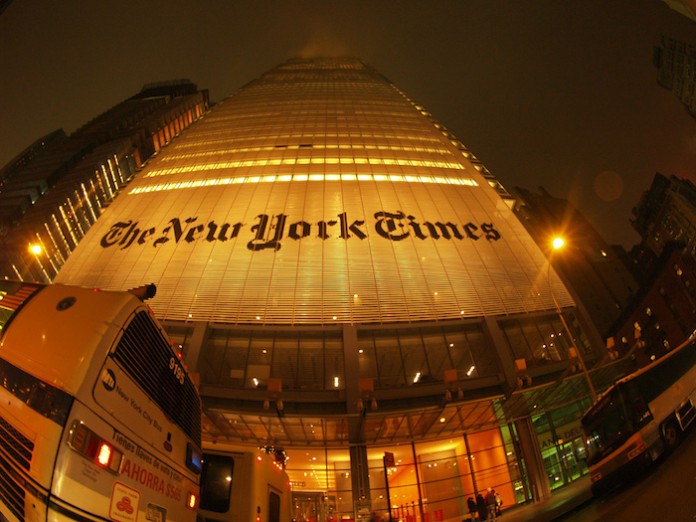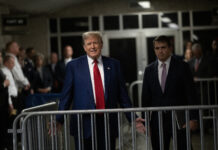
By Ira Stoll
A New York Times news article about Iran’s nuclear program falsely claims that it was completely abandoned in 2003.
The Times article, a dispatch from Brussels under the bylines of Steven Erlanger and Milan Schreuer, includes this paragraph:
Tehran has always denied that it ever intended to build a nuclear weapon, though Western intelligence agencies said Iran tried to do just that before abandoning the effort in 2003. While Iran continued to work on ballistic missiles, there has been no evidence found of a nuclear weapons program since that date.
“No evidence”?
Here is a 2011 news article from The New York Times itself, by David Sanger and William Broad. It appeared under the Times headline, “U.N. Agency Says Iran Data Points to A-Bomb Work”:
United Nations weapons inspectors have amassed a trove of new evidence that they say makes a “credible” case that “Iran has carried out activities relevant to the development of a nuclear device,” and that the project may still be under way…. The report laid out the case that Iran had moved far beyond the blackboard to create computer models of nuclear explosions in 2008 and 2009 and conducted experiments on nuclear triggers. It said the simulations focused on how shock waves from conventional explosives could compress the spherical fuel at the core of a nuclear device, which starts the chain reaction that ends in nuclear explosion….
The inspectors agreed with a much-debated classified United States National Intelligence Estimate issued in 2007 that Iran had dismantled a highly focused effort to build a bomb in late 2003, but found significant recent work, though conducted in a less coordinated manner.
Here is the way the Nuclear Threat Initiative, a nonpartisan group led by former President Barack Obama’s energy secretary, Ernest Moniz, describes the history:
On 21 September 2009, ahead of the public revelation by the leaders of the United States, France, and the United Kingdom, Iran disclosed to the IAEA that it was building a second pilot enrichment facility. According to IAEA Spokesperson Marc Vidricaire, Iran’s letter “stated that the enrichment level would be up to 5%,” and the Agency was assured that additional information would be provided in due time. The facility was located in an underground tunnel complex on the grounds of an Islamic Revolutionary Guards Corps (IRGC) base near the city of Qom. Managed by Iran’s Atomic Energy Organization, the Fordow Fuel Enrichment Plant (FFEP) was slated to hold 2,784 centrifuges, and began operations using 696 centrifuges in late 2011. Moreover, Iran contradicted its declaration to the IAEA concerning planned enrichment levels by moving 19.75% enrichment activities from Natanz to Fordow. A May 2012 report from the IAEA raised concerns over the activity at Fordow, citing uranium enriched past the stated target of 19.75%, and the “difference between the original stated purpose of the facility, and the purpose for which it is now used.” The plant’s size, secrecy, and location on an IRGC military base led some analysts in the U.S. government to argue that Iran constructed it in order to produce HEU for nuclear weapons.
More information about that Fordow facility was in the archive seized by Israeli operatives and publicly disclosed by Prime Minister Benjamin Netanyahu earlier this year. A May 2018 article by David Albright and Frank Pabian of the Institute for Science and International Security reported: “Iran was building this plant at a time when US intelligence agencies were stating that Iran’s nuclear weapons program had ended. The linkage of this facility to the AMAD program provides new evidence that in 2009 Iran was actually planning to create a facility in secret to make the raw ingredient for nuclear weapons, namely weapon-grade uranium.”
For the Times to report, as context and without attribution, the false and sweeping claim that there has been “no evidence” of Iranian nuclear work since 2003 is just irresponsible, bad journalism. It warrants a correction by the Times. Or, if the Times really believes it is true, it should go back and correct the 2011 article about the U.N. inspectors finding “significant recent work” and the “computer models of nuclear explosions.”
Careful readers of the Times (or Matzav.com) may recall that this is hardly the first time that the newspaper has tried to put the friendliest possible face on the Iranian nuclear program and to minimize the evidence about its threat.
{Matzav.com Newscenter}












Perhaps it would be news if THEY TOLD THE TRUTH?
iran lies. the NY Times lies. Boruch HaShem sheh’lo osahni goy
Fake news. Kristen Gillibrand and Cory Booker swore to us that Iran is a harmless little fuzball who loves Israel and loves the US. All statements & threats to the contrary, are just a showing of a good sense of humor by the Iranians. They are good jokesters.